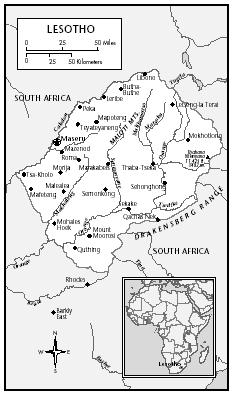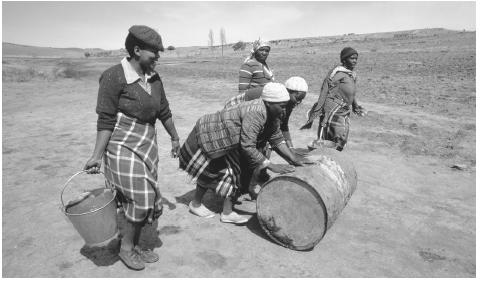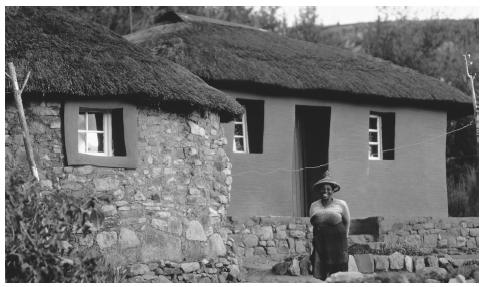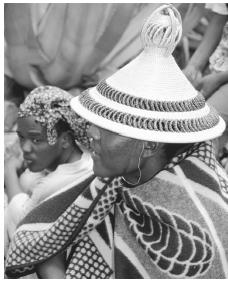Lesotho
Culture Name
Mosotho (singular); Basotho (plural)
Alternative Names
Kingdom of Lesotho; formerly known as Basutoland
Orientation
Identification. The area now called The Kingdom of Lesotho (pronounced le-Soo-too) was originally Basutoland. Both names derive from the common language, Sotho, which was spoken by the many groups which united to form the nation in the early 1800s. Lesotho is often referred to as "The Kingdom in the Sky" or "The Switzerland of southern Africa" because of the stark beauty of its rugged mountainous terrain. It is also described as "The Hostage State" due to the unfortunate situation of being completely surrounded by and dependent upon the Republic of South Africa.
Location and Geography. Covering 11,718 square miles (30,355 square kilometers), the Kingdom of Lesotho is approximately the size of Maryland. The area is ruggedly mountainous, landlocked, and completely surrounded by The Republic of South Africa. It lies between latitudes 28 degrees and 31 degrees south and longitudes 27 degrees and 30 degrees east. The lowlands in the west and south rise from forty-five hundred feet (fifteen-hundred meters) to the highlands of the Maluti and Drakensberg mountain ranges whose highest point, Thabana Ntlenyana, is approximately 10,400 feet (thirty-five hundred meters). Lesotho is unique as being the only nation in the world with all of its land situated more than 3,280 feet (one thousand meters) above sea level. The terrain consists of high veld, plateau, and mountains. The climate is temperate with hot summers and cool to cold winters. A long rainy season during the summer months (December to February) combined with freezing conditions in the winter (June to August) creates adverse travel conditions which isolate much of the highland areas. A wealth of rivers and waterfalls makes Lesotho valuable to the surrounding arid industrial areas of South Africa. The soils are poor, a result of over-grazing, over-cropping, and serious erosion, with only one-eighth of the land being arable.
Demography. The population of Lesotho, in 1998, was estimated to be 2,089,289 with a growth rate of 1.9 percent. At the end of the twentieth century these figures could alter rapidly as the HIV/AIDS crisis impacts the general population. The people of Lesotho are called Basotho (plural) and Mosotho (singular). The culture is cohesive, with Basotho comprising over 99 percent of the country's population, the remainder being of Asian of European origin. Most Asians are traders while the Europeans are businessmen, technicians, government officials, missionaries, and teachers. The highlands are sparsely populated with most of the administrative headquarters and towns located in the lowlands area.
Linguistic Affiliations. Sesotho, or Southern Sotho, is spoken in Lesotho as well as in parts of South Africa. Sesotho was one of the first African languages to develop a written form and it has an extensive literature. English is the second official language, dating back to 1868 when Lesotho was placed under the British for protection against South African aggression. Zulu and Xhosa are spoken by a small minority.
Symbolism. The spectacular scenery of Lesotho's rugged mountains, massive gullies (called dongas ), and sparkling waterfalls create a tourist's dream destination. Picturesque villages, herdboys with their flocks, men on horseback, and women wearing the national dress of Moshoeshoe depicted in the

The Basotho hat, a conical woven hat with a distinctive topknot, is a symbol of Lesotho's unification. It depicts a mountaintop, conical and topknotted, which is visible from the fortress and tomb of Moshoeshoe I (pronounced mo-SHWAY-shway) near Masaru. Both men and women invariably wear the wool Basotho blanket as a cloak, regardless of the season. The careful selection of color and pattern allows for individual expression.
Everywhere in Lesotho one will see the small, sturdy Sotho pony, adept at negotiating the steep mountains and gullies and indispensable for carrying the grain to the mill for grinding. The nation's flag, adopted in 1987, has diagonal stripes of white, blue, and green. White is symbolic for peace ( khotso ), blue for rain ( pula ), and green for plenty ( nala ). A shield that is part of the country's coat of arms appears in the upper left diagonal space. The national anthem is "Lesotho, Land of our Fathers" ( Lesotho fatse la bontat'a rona ).
History and Ethnic Relations
Emergence of the Nation. Lesotho was originally inhabited by the Bushmen who roamed southern Africa, as evidenced by the Bushmen drawings and paintings in the river gorges. During the 1700s and 1800s, tribal wars in southern Africa decimated many tribes. Survivors of the wars fled into the highlands of what is now Lesotho and, under the leadership of an African chief named Moshoeshoe, formed the current Basotho ethnic group. Moshoeshoe established fortresses in the mountains and consolidated the Sotho-speaking inhabitants into a nation in the early 1800s. During the middle of the 1800s, the Basotho nation lost much of its territory to the Boers in a series of wars. Moshoeshoe appealed to Great Britain for protection and the remaining area became a British protectorate. In 1966 the nation gained independence and the constitutional monarchy of Lesotho was established. Moshoeshoe II, great-grandson of Moshoeshoe I, was installed as king and head of state, and Leabua Jonathan served as prime minister and head of government. Although Lesotho has undergone politic strife and change during the past thirty years, the Basotho are bonded by a deep reverence for the royal family and a fierce determination to remain an independent nation.
National Identity. Lesotho is a very homogenous nation, both in terms of the ethnic makeup of its population as well as religion and culture. Lesotho's strong cultural identity does not translate into a strong national identity, however, since its location deep in the heart of South Africa has historically forced the small country into dependence on its much larger neighbor.
Ethnic Relations. The Sotho ethnic group comprises almost 100 percent of Lesotho's population. The homogeneous makeup of the country has allowed Lesotho to avoid much of the civil unrest that has plagued other African nations with more ethnically diverse populations.
Urbanism, Architecture, and the Use of Space
Over 80 percent of the population live in the lowlands where soil conditions are more favorable for agriculture. The western border of Lesotho has one of the highest population densities in Africa. Maseru (ma-SAY-roo), population of 400,000, is the capital city, located in this western border area. Political strife in 1998 resulted in a frenzy of looting and burning which destroyed the main thoroughfare and infrastructure of Maseru. Although much rebuilding has occurred, many historical buildings were lost. Other semi-urban areas are called "camptowns" and are very rustic in appearance. The main camptowns are Teyateyaneng, population twenty-four thousand; Leribe, population three-hundred thousand; Mafeteng, population 212,000; Mohale's Hoek, population 184,000. Most Basotho live in villages of fewer than 250 people.
The cattle pen ( krall ) is the nucleus of family groups who build their huts in a spaced fashion around the pen. Traditional huts are constructed of mud and dung walls with thatched roofs. These round houses ( rondovals ) are often decorated with bright designs. Each village has a meeting place ( khotla ) where business is conducted. The areas around the villages are owned in common by the people and the land is assigned by the chief for family farming.
Food and Economy
Food in Daily Life. A three-stone fireplace in the courtyard is the focal point of the Basotho women's daily activity. Here they prepare the pot of cornmeal porridge ( pap-pap ) which is the staple of the Basotho. Usually a sauce of peas, chopped greens, or other vegetables accompanies the thick porridge, and on special occasions a chicken is added to the pot. During the summer season, local peaches, and small, hard fruits add variety to the diet. In the winter, family members sit around the three-stone fireplace and roast ears of dried corn.
A local beer ( joale ) is brewed in a large vat placed on the three-stone fireplace. This beer is the center of informal neighborhood gatherings and provides a small income for the family. Milk is often served as a soured drink.
Maseru has a number of modern restaurants that are mostly patronized by business and professional people and tourists.
Food Customs at Ceremonial Occasions. In the villages, cultural rites are predominately centered around the sacrifice of a cow. Funerals often drain a poor family's assets as a cow must be purchased at great expense. A family's honor is dependent on the quality and quantity of food at wedding and funeral gatherings—spit-roasted cow and chicken are mandatory.
Basic Economy. Lesotho is a developing country with a free-market economy. It boasts few natural resources and is dependent on imported food and materials to meet the basic needs of the population. Nearly all families engage in subsistence farming, consisting mostly of corn, wheat, peas, and beans, but the depleted soil does not yield sufficient crops to feed them. Lesotho's economy is fragile, even with the benefits it derives from South Africa which include a partially shared customs union, a single currency (the South African rand is used interchangeably with the Lesotho loti ), and an integrated communications system. A major sustaining factor in the country's economy is employment found in South African mines, farms, and industries. Approximately 35 percent of active male wage earners work most of the year in surrounding South Africa, resulting in family income but having a detrimental effect on family life. In the United Nations Development Program's ranking of countries of the world in 2000, which considers the factors of life expectancy, income, education, and health care, Lesotho ranked 127th out of 174 countries.
Land Tenure and Property. All land is held in trust for the Basotho nation by the king and may not be alienated. The local chiefs allocate farmland to individuals, and user rights are generally available to married males. A 1979 act increases security of tenure by recording rights of inheritance and allowing mortgaging and subletting of land.
Commercial Activities. Lesotho's abundance of cattle, sheep, and goats provides a basis for a wool and mohair industry. Although there are no other large industries, small industries and businesses are supported by national and foreign assistance and are having some success. Perhaps the most promising, although highly controversial, effort to improve the economy is the Highlands Water Project which is designed to utilize the nation's valuable resource of water to provide electricity, employment, and economic development for the general population. The project involves the construction of a series of six dams and hundreds of miles of tunnels to funnel water into the arid industrial areas of nearby South Africa, for which Lesotho will receive monetary compensation. The controversy arising from the project revolves around the detrimental effect of the relocation of area communities, the delayed compensation for the loss of ancestral lands,

Major Industries. Lesotho has a wide variety of light industries, which include tire retreading, tapestry weaving, diamond processing, and production of textiles, electric lighting, candles, ceramics, explosives, furniture, and fertilizers.
Trade. Lesotho has trade relations with South Africa, Botswana, Swaziland, Namibia, North America, and Europe. Imported items are primarily corn, clothing, building materials, vehicles, petroleum products, machinery, and medicines. Exports include clothing, furniture, footwear, and wool products.
Social Stratification
Symbols of Social Stratification. Cattle represent wealth in Lesotho and the Basotho value cows above money. The wealthy villager usually lives in a concrete block house with a metal roof instead of a rondoval, and usually has two outdoor bathrooms as opposed to the single outhouse other families possess and often share. The very wealthy send their children to private schools and often to the one university in Lesotho at Roma, or to England or Canada for further education. In the villages, an automobile is an unusual and significant symbol of upper social status.
Government. The government of Lesotho is a constitutional monarchy with the capital in Maseru. The country is divided into ten administrative districts. The legal system is based on English common law and Roman Dutch law. The executive branch has a king as chief of state and since 1996 King Letsie III has filled this position. The legislative branch is composed of a bicameral parliament with a senate appointed by the ruling party and an assembly chosen by popular vote. The judicial branch is the high court, with a chief justice appointed by the monarch. The monarchy is hereditary and is a living symbol of national unity with no executive legislative powers. In January 1993 Lesotho became a democracy. The constitution was adopted on 2 April 1993.
Leadership and Political Officials. There are three major political parties: The Basotho National Party (BNP), the Basotho Congress Party (BCP), and the Marematlou Freedom Party (MFP). The BNP was the major force behind Lesotho's drive for independence and became the government's ruling party following independence in 1966. The BNP maintained control of the government by suspending elections and the constitution in 1970 and remained

Social Problems and Controls. Traditional authority is the basis of village government. The system of chieftaincy follows the progression of paramount chief (the king), senior chiefs, sub-chiefs, headmen and sub-headmen. Their primary role is the authority to distribute the land of the nation to the people. Many political affiliations are passed down through the chain, with entire villages voting in accord during an election. Village crimes of a minor nature are judged in the village court, often a grassy area under a tree. Local groups mete out the punishments that are handed down. Serious crimes of theft or murder are removed from the village to the regional and national courts and institutions of imprisonment.
Military Activity. The Lesotho Defense Force (LDF) and the Lesotho Mounted Police comprise the nation's security forces. These two factions have developed an antagonistic relationship since 1997 when the army was called upon to put down a serious police mutiny.
Social Welfare and Change Programs
Lesotho has received economic and social welfare aid from a number of countries including the United States, the United Kingdom, the European Union, and Germany. The escalating crisis of HIV/AIDS has mobilized assistance from a variety of sources including UNAIDS/WHO. The United States Peace Corps has been active in Lesotho since 1966. The volunteers are involved in working in the fields of agriculture, education, rural development, women's issues, and the environment. In 2000, specially trained volunteers were enlisted to address the HIV/AIDS issue in this and other African nations.
Gender Roles and Statuses
Division of Labor by Gender. Most of the agriculture and home building is done by the women. They hoe, plant, and weed, and harvest the crops. They walk great distances to obtain firewood and carry the load home on their backs, often with an infant wedged between the tree branches. Water must be carried from the village pump for cooking, drinking,

Men are primarily responsible for the livestock. Boys begin training for herding at age five or six. In the highlands, where pasture is scarce, herdboys often spend months alone with their flocks in a mountain valley some distance from their home. Girls similarly begin life-role training as soon as they are able to carry a sibling on their back and a pail of water on their head.
The Relative Status of Women and Men. As in most African countries, a female has no power, authority, right, or privilege, unless it is granted by a male. A wife is the property of her husband. However, women play a powerful role through their religious organizations and societies and have attained suffrage.
Marriage, Family, and Kinship
Marriage. Lesotho is a blend of past and present, traditional and modern beliefs and practices. While church ceremonies are customary for weddings, the practice of extracting brideswealth from the man's family continues, making a family of daughters a lucrative situation. In turn, the bride becomes the property of the man, and leaves her family to live with the family of her husband.
Domestic Unit. The domestic unit consists of any number of the extended family. Often second or third cousins become "brothers" or "sisters." Grandmothers become official mothers. By tribal custom, widows become a wife of the brother or other male member of her deceased husband's family.
Kin Groups. The clans of the Sotho are often named for animals such as crocodiles and bears. The line of descendants is through the male, and members of the same clan are allowed to marry relatives as close as cousins.
Socialization
Infant Care. Compared to western standards, infant care in Lesotho is casual. The infant and young child spend much of their first two years bound to their mother's backs as she performs her household chores, hoes the fields, and markets or travels. Babies usually nurse for up to two years of age or until a new baby is born. At that time, an older sister usually assumes the caretaker role.
Child Rearing and Education. "It takes a village to raise a child" is a well-known and accurate description of African practices. Every village woman is eligible to correct an erring child, to rescue one in difficulty, and to encourage all. When a child is able to begin school (age varies from five to ten years) the mandatory school dress or shirt is passed from one family to another. Many boys do not attend school for years because they begin at age five or six to herd and care for the livestock.
Higher Education. There are two major institutions of higher learning in Lesotho: the National University of Lesotho and the Lesotho Agricultural College. A very small percentage of the population reaches this level of education. Very wealthy families send their children to higher education in England.
Religion
Religious Beliefs. Religion in Lesotho is a mix of traditionally based ancestor worship and Christianity (about 80 percent), with a small representation of Islam. The main church groups are Catholic, Anglican, and Dutch Reformed. The dominance of the Catholic religion reflects the church's involvement in education, with over 75 percent of all primary and secondary schools being owned and managed by Catholics. Many church services include traditional Lesotho rituals such as chanting, drumming, and cultural costumes.
Medicine and Health Care
Lesotho is essentially a healthy country. A good climate eliminates the widespread African problem of malaria. The primary diseases are chronic rheumatism, respiratory tract infections, malnutrition, and venereal diseases in addition to an escalating number of HIV/AIDS cases. Health centers, mountain dispensaries, and traditional medical practitioners are available and primarily used by the village population.
Secular Celebrations
The two days which all of Lesotho celebrates are Moshoeshoe's Day (12 March) and Independence Day (4 October). Moshoeshoe's Day is for the nation's school children, who prepare throughout the year for choir and sports competitions. Independence Day is a time for formal state ceremonies, speeches, and traditional dance group performances.
The Arts and Humanities
Literature. Sotho literature is dominated by folktales and praise poems. Early in the 1900s a Masotho named Thomas Mofolo wrote the famous and widely read novel Chaka .
Performance Arts. Traditional music, dance, and literature combine in Sotho cultural performances. Storytellers, dancers, and musicians join with audience chanting, clapping, and singing to retell ancient folktales. The involvement with mining has produced a unique tradition of singing and dancing males, with high-kicking group dances. Many handmade instruments include whistles, drums, rattles, and stringed instruments.
Bibliography
Africa South of the Sahara 1999 , 1998.
Ashton, Hugh. The Basuto , 1952.
Central Intelligence Agency. "Lesotho." World Fact Book , 1995.
Hull, Richard. Modern Africa , 1980.
Johnson, D. "Lesotho," World Biographical Series , 1996.
"Lesotho," Epidemiological Fact Sheet on HIV/AIDS and Sexually Transmitted Infections. UNAIDS/World Health Organization , 2000.
"Lesotho," The New Book of Knowledge , 1996.
Web Sites
"Sesotho-Southern Sotho." 2000. http://www.cyberserv.co.za/users/~jako/sesotho.html
U.S. Department of State Annual. "Lesotho," Report on International Religious Freedom for 1999 http://www.state.gov/www/global/human_rights/irf/irf_rpt/1999/
—P ATRICIA O SBORN S TODDARD
Thank you, and God bless you!
Thank you, and God bless you!
Thank you!!
WHEN EACH DANCE IS PERFORMED AND KINDS OF FOOD.
The bride price (mahadi) its not a luctritive business where a woman is traded as property. Its a token of appreciation to thank the brides family for raising for the recieving family. They gain a daughter whom will be a mother to their future generation. Most of the time the mahadi money is used to throw a wedding party and its a brides family responsibility and they have to help the newly weds to start up their new life(ho phahlella) by buying practical wedding/household gifts.
Its really important to do a little more research before making bold and general statements. I'm not denying the system can get abused but so can many more in the world. The woman would belong to her husbandfamily not as property as part of the family. This is done around the world and the exchange of money is similar to western people buying the most expensive wedding ring. It does not at all mean the woman is bought but that she is married. I am sorry for the typos and not being able to be more elaborate to share about customs of our culture. I'm using a phone
kind regards
Beatrice
please do another research about the marriage part of Basotho.
Does anyone knows how I can access the literature? I need to learn about the Basotho traditional way of life in order enrich the life of my offspring's about their origin.
I noticed that in the comments on the articles, some people were not in agreement with certain parts of the article and providing different explanation. I want to suggest that we form a group that'll assist in providing proper direction for the benefit of all of us who are keen on learning our origin.